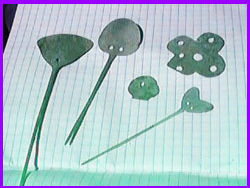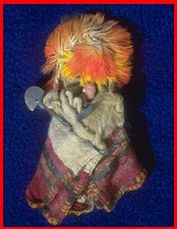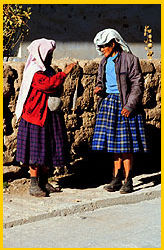 |
 |
 |
 Burial Artefacts
Burial ArtefactsPart 2 (back to Part 1) The Shawl Pins Tupus, or shawl pins, are a traditional accessory to female Inca clothing. All women's outer garments were fastened with shawl pins, so today archaeologists can usually take the shawl pin as an easy signifier of the sex of statuettes and mummies. We know Sarita, for example, is a female because there is a shawl pin fastening her outer wrap together. Shawl pins are, in fact, still worn today by women in some indigenous cultures in Chile and Bolivia. What is significant about the shawl pins found by Jose Antonio Chavez and Johan Reinhard on the summit of Sara Sara is that they are not classic Inca design. "They are a little more complicated than the simple tupus made and worn by the Inca," says Conklin. These shawl pins were perhaps specially designed pieces used for a significant female sacrificial human offering (like Sarita) to the mountain deities.  Statuettes and Clothing
Statuettes and ClothingHuman figurines, like this one buried with Juanita, accompany all of the sacrificial children found to date on Andean peaks. They are believed to be companions for the children in their journey beyond death. Made of castings and stamped metal, the figurines are always clothed in textiles and often have feather headdresses, as pictured here. The clothing found on the figures, and indeed on the mummies themselves, is always significant in identifying status and rank.  Michael Moseley in "The Incas and Their Ancestors" writes about the
cultural significance of clothing and clothmaking in Inca society: "Pride in
clothing one's family is a hallmark of Andean femininity, and clothmaking
occupied more people for more time than any other craft. All women wove, from
the humblest of peasants to the wives of kings. Queens and empresses wove as
an Andean symbol of their femininity...What people wove and wore—decoration,
iconography, and quality—established their ethnic identity and indicated
their rank and status. Heads of state wore the finest of materials, rich in
color and design, and often fashioned from exotic fibers such as vicuna wool,
embellished with threads of gold and silver, or with bright feathers of
tropical birds."
Michael Moseley in "The Incas and Their Ancestors" writes about the
cultural significance of clothing and clothmaking in Inca society: "Pride in
clothing one's family is a hallmark of Andean femininity, and clothmaking
occupied more people for more time than any other craft. All women wove, from
the humblest of peasants to the wives of kings. Queens and empresses wove as
an Andean symbol of their femininity...What people wove and wore—decoration,
iconography, and quality—established their ethnic identity and indicated
their rank and status. Heads of state wore the finest of materials, rich in
color and design, and often fashioned from exotic fibers such as vicuna wool,
embellished with threads of gold and silver, or with bright feathers of
tropical birds."Continue Expedition '96 | Dispatches | Mummies | Lost Worlds | Mail Resources | Site Map | Ice Mummies of the Inca Home | BBC Horizon Editor's Picks | Previous Sites | Join Us/E-mail | TV/Web Schedule About NOVA | Teachers | Site Map | Shop | Jobs | Search | To print PBS Online | NOVA Online | WGBH © | Updated November 2000 |